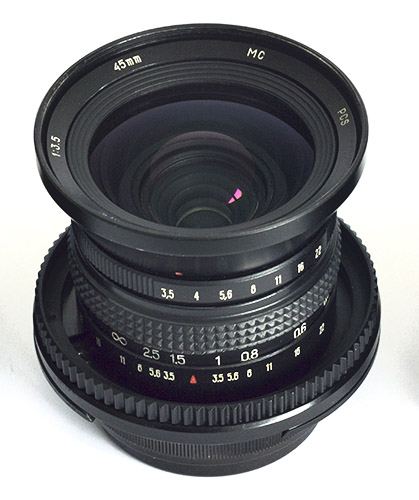
[w45pc07w.jpg]
The Pentacon Six System
Lens Data Summary
Wiese
Shift & Shift/Tilt Lenses

[w45pc07w.jpg]
| Towards the
end of the 1990s and in the early part of this
century, a company called Wiese Fototechnik from
Hamburg in Germany advertised a range of medium
format cameras and lenses which all appeared to be
based on products from the Arsenal factory in
Ukraine. The company still has a website,
which can be found here: http://www.wiese-fototechnik.de/Website/Startseite.html
They still specialise in photographic
equipment. However, few of the products
offered at that time are now advertised on their
website. |
| The
shift lens shown above and in the image to the
right here has a maximum aperture of f/3.5 and
appears to be based on the Mir 26B wide-angle lens
from Arsenal in the Ukraine. Near the base
(back) of the barrel appear indented into the
barrel side the words “MADE IN UKRAINE”, which
have not been filled with paint. This is
just visible in the image to the right, a short
way after the 0.5 M on the focussing ring. The Arsenal lenses formerly bore the letters “CCCP” for “USSR”, so this lens was completed in the Ukraine subsequently to the dissolution of the Soviet Union. It should therefore probably be referred to as an “ARSAT” lens, the name that the Arsenal factory adopted for its cameras and lenses in the early 1990s. Examination of the focussing scale on the lens barrel and the depth-of-find marking on the index ring behind it reveal that this is, indeed, a Mir 26B lens. However, the index ring has been moved further forward than on the unmodified version of the lens, presumably as part of the steps taken to allow space for the shift ring while not preventing infinity focus. The consequence is the bottoms of the focussing scale numerals are slightly covered by the index ring, although this is not enough to cause any difficulty in reading them. The ribbed focussing ring is also narrower on the Wiese lens. More information on the Mir 26B wideangle lens can be found here. WARNING: This image shown here on the right has been made from two separate photographs, so the size comparison may not be completely accurate! However, it does facilitate comparison of some of the similarities and differences between the two lenses. |
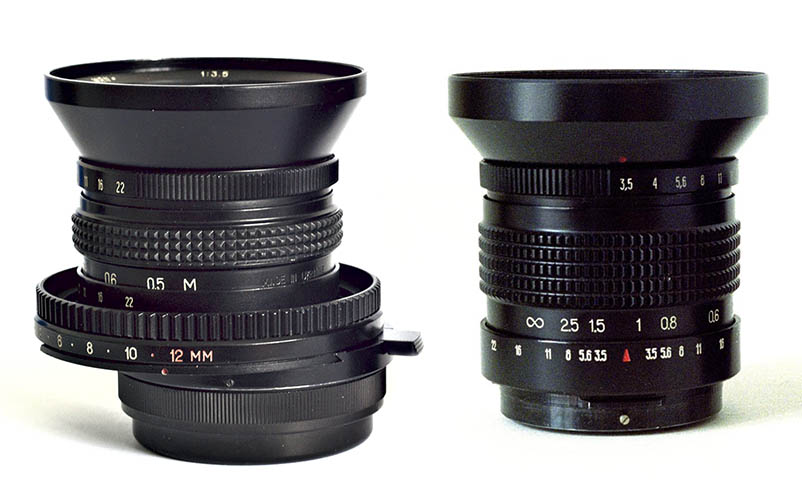 The Wiese 45mm PCS compared with
the Mir 26B 45mm lens.
[w45pcm26.jpg] |
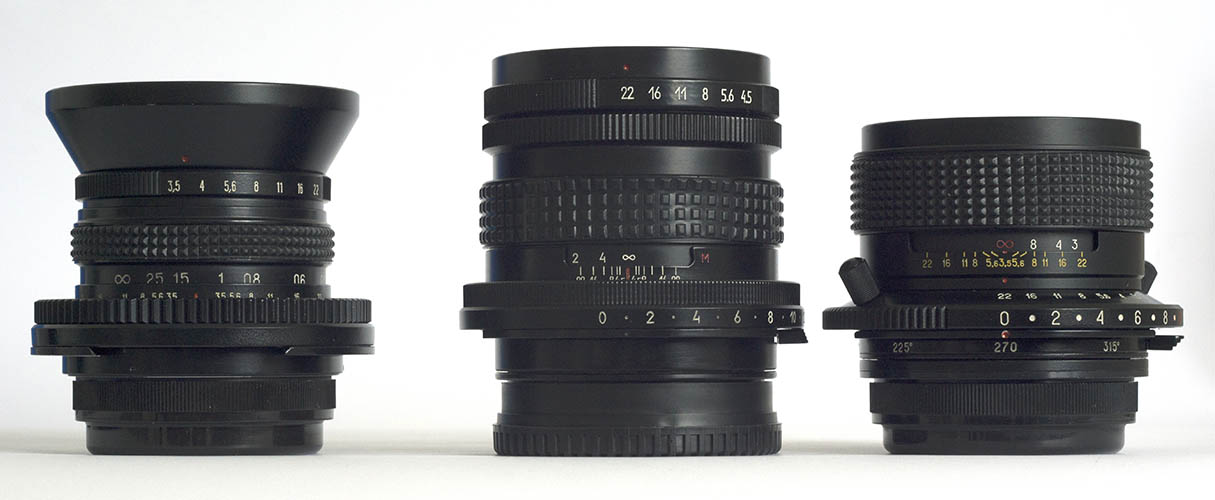 Three shift lenses photographed together to enable the relative sizes to be compared. From left to right: 45mm Wiese PCS, 55mm Arsat PCS and 65mm Hartblei PCS. [w45pcs09.jpg] |
| The shift
ring can be rotated to give a variable amount of
shift from 0 to 12mm. These are indicated by a
0 and even numbers between 2 and 12, with a dot
between each pair of numbers. The 12mm
position and the dot before it (11mm) are marked in
red, presumably to indicate that there will be some
vignetting of the image at the opposite end from the
shift, if the full 6×6 format is used. The
ring rotation to achieve full shift covers an arc of
90°. There are no détentes in the ring to
indicate the millimetre positions. Movement is
smooth but not as silky as the focussing on the 80mm
lens from Wiese. See information on that lens
here. We note that on the Hartblei 45mm Super-Rotator tilt/shift lens the 11mm and 12mm shift positions are marked in red and just after them there is the indication “4.5×6”, also in red, to show that these two positions should only be used when shooting for the 645 format (or when one plans to crop a 6×6 image accordingly), to avoid vignetting entering the image area. There is more information on the Hartblei Super-Rotator here, here and here. |
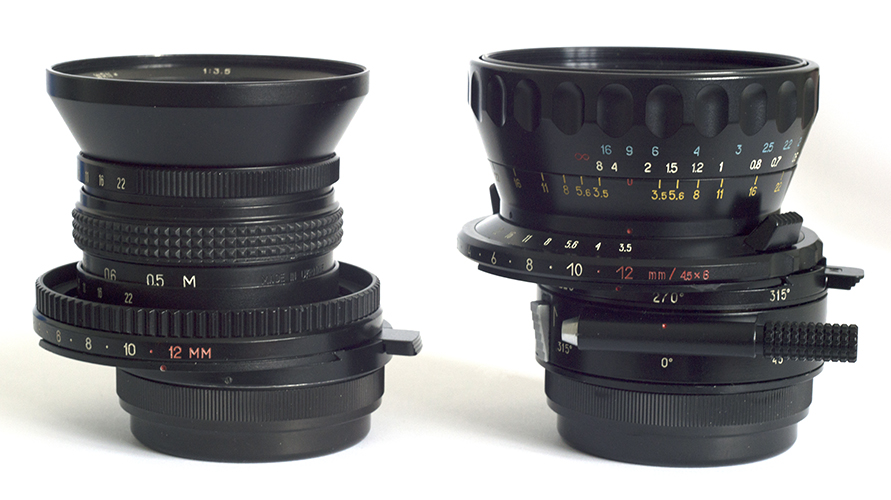 The Wiese 45mm PCS shift lens next to the Hartblei 45mm Super-Rotator tilt/shift lens [w45pcs05.jpg] |
| Test
Results Here are a couple of test shots taken with this Wiese 45mm PCS shift-only lens. They are of the Church of St Mary the Virgin in Saffron Walden, which does reveal some of the problems encountered when photographing the exteriors of large historic buildings. The church has an impressive and extremely tall spire at the front, but the building is hemmed in by other buildings at the front, and it is not possible to get far enough back to get a shot that I considered reasonable, even with the 45mm wide-angle lens, without tilting the camera up at an acute angle and so ending up with a massive amount of keystoning. Even with this shift version of the lens, the spire was too high and the available distance from it was too short to get the sort of picture that I wanted. I therefore went round the back, and discovered another problem: after a few yards, the land drops down steeply, so that even though one can get further away, one ends up having to tilt the camera up even more! When the church was built in the thirteenth century, the architects clearly did not take into consideration the needs of architectural photographers in the 21st century! (In fact, the present form of the spire only dates back to 1832, a handful of years before the invention of photography. For more information on the history of the building, see the church’s website, here: http://www.stmaryssaffronwalden.org/about/history-and-guides/ Church website visited on 17th October 2018) So here are the best shots that I could get, both shot on my usual Pentacon Six, with Fuji PRO160NS negative film at 1/125 sec at f/11. |
||
 Here I ignored the red warning markings on the lens, and shifted it up by 11.5mm, which is not advised for 6× 6 cameras. The resulting vignetting (darkening) in the top corners is obvious. In other respects, the image is reasonably satisfactory. However, in the limited space available, I was not able to avoid converging verticals. [C564_1-2.jpg] |
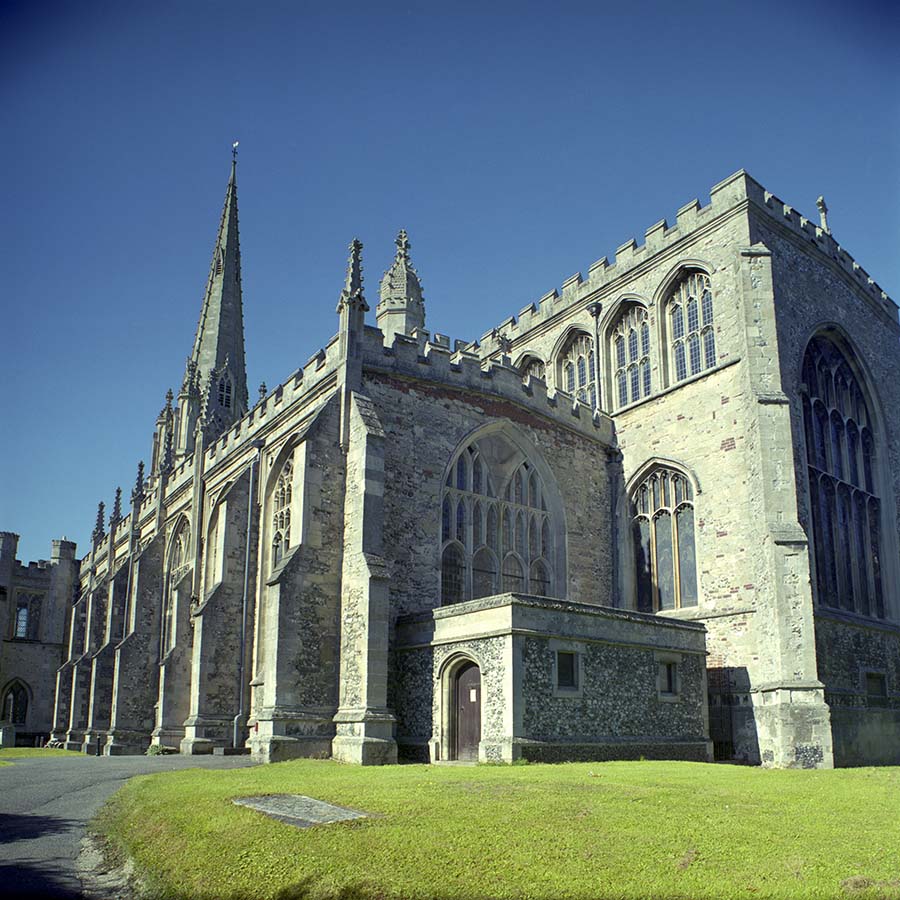 For this next shot, I slightly changed my position, but this only took me lower down the slope at the back of the church! Nevertheless, I reduced the shift up to 10mm, still at the limits of what is advised for 6 × 6 cameras. The vignetting is only slightly reduced. [C564_3.jpg] |
|
I think that it is fair to say that with both shots the image resolution with this lens is perfectly satisfactory. I could easily print either image more than a metre wide, without any obvious chromatic aberration (although it is present and visible at silly levels of magnification). With a slight vertical crop, most of the vignetting could be removed, especially with the image on the right, where the shift up was 10mm. In other images with a 9mm shift up, no vignetting is obvious. Visitors to this website wishing to evaluate this lens with a view to purchasing one will be able to decide whether the vignetting at 10mm shift and more is acceptable or not – always assuming that they wish to shoot in full 6 × 6 format, since vignetting will not be present in 6 × 4.5 format, even with extreme shift. As I explain elsewhere (here), with some images a degree of converging verticals may be acceptable or even appear more normal than when they are completely eliminated. The same page also shows a picture taken with the 45mm Hartblei shift-only lens. Further results of tests with the 45mm Hartblei shift-only lens can be seen here. |
||
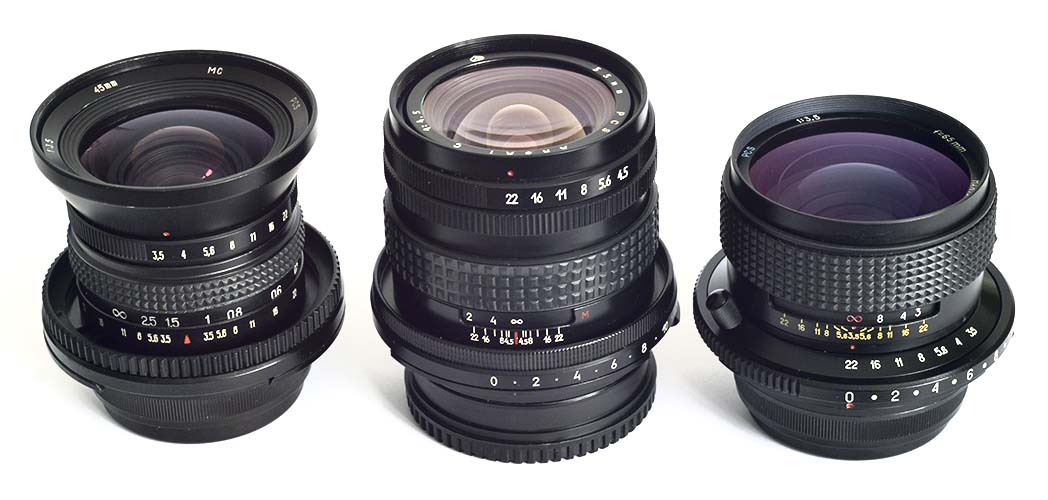 The 45mm Wiese PCS, 55mm Arsat PCS and 65mm Hartblei PCS seen from higher up. The numerals that show the amount of shift on the Wiese lens are not visible in this picture. [w45pcs10.jpg] 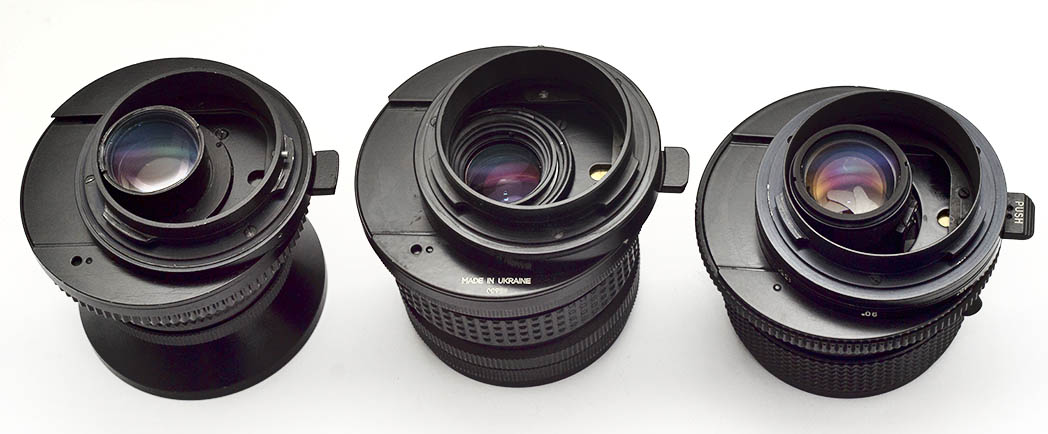 Rear view of the same three lenses, fully shifted [w45pcs11.jpg] |
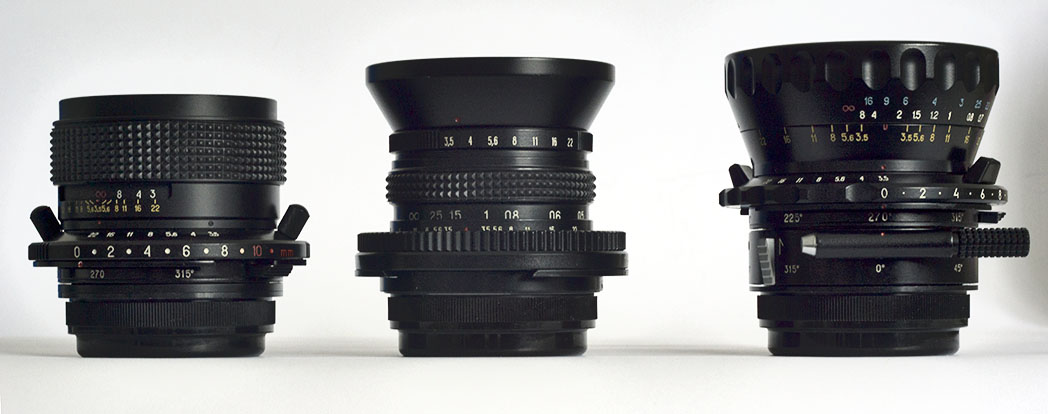 From left to right: The 65mm Hartblei PCS shift, the 45mm Wiese PCS and 45mm Hartblei PCS Super-Rotator. [w45pcs08.jpg] It is thus possible to shift down, sideways or in any other direction. The rotation lock is released by pushing backwards (towards the camera body) a little tab that is located at the base of the lens when it is in its default setting, i.e., with the focus and aperture index markers at the top of the lens. On the Wiese 45mm PCS, accessing this tab is difficult when the lens is in 0 shift position. The design of this tab and the 360° rotation with détentes every 15° is also very similar on the Wiese and the Arsat lenses. However, the Arsat lens is bigger, on the whole bulkier (though smaller at the front) and slightly heavier – see pictures higher up. The 55mm Arsat lens also benefits from a pre-set mechanism that can be operated by a stop-down ring or by a double cable release. Details of this can be seen here. On a Pentacon Six with a metering prism, the lens can be shifted fully up without the shift ring hitting the metering prism, even though this projects forwards of the camera top plate. |
This
lens can be mounted on an Exakta 66 with its
metering prism, but shift movements are extremely
limited because of the forward overhang of this
prism and its contact points. The lens
cannot be shifted up because of the prism, nor
down, since the tab which permits rotating the
lens is also blocked by the prism. So, it
can be shifted sideways, and the camera can be
rotated for shifts in other directions. (Up
is the direction most often needed, to cope with
tall buildings, etc.)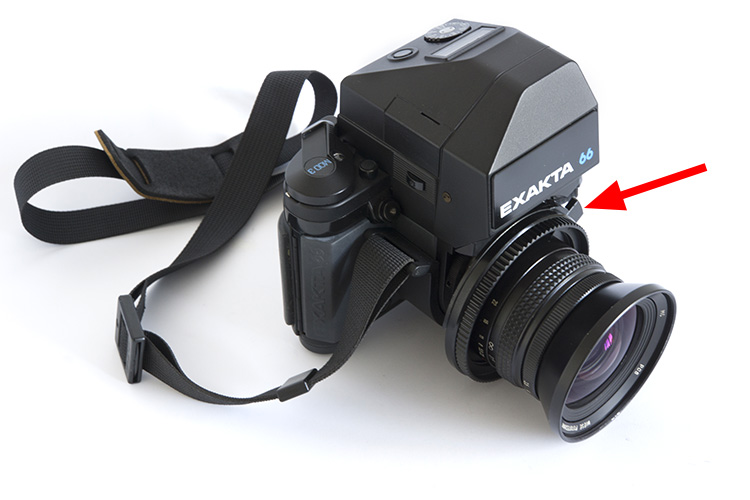 The red arrow shows the lens tab which enables it to be rotated, in order to change the shift direction. As will be clear, it can hardly go any further up (rotating anti-clockwise), and if we try to rotate to the right (clockwise), the lens’s own shift ring will foul the front of the metering prism contact points cover. [e66w45pc2.jpg] |
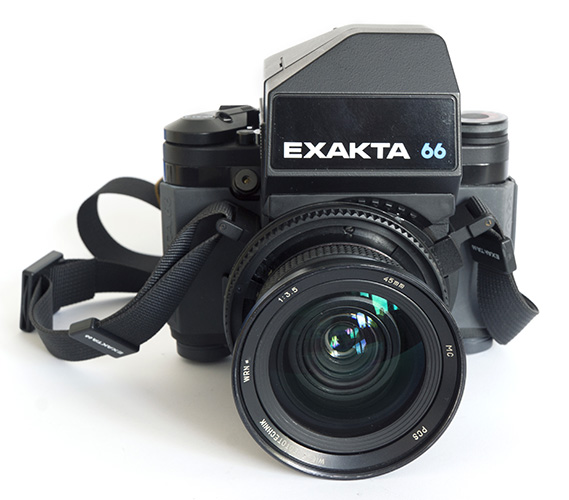 In
the above image, the Wiese 45mm PCS can be seen
mounted on an Exakta 66 with the metering prism in
place, The lens is fully shifted 12mm to the
left, as viewed from the front of the camera
[e66w45pc1.jpg] |
| However as – along with all non-Schneider lenses in the Exakta 66/Pentacon Six mount – this lens from Wiese has no contacts for the Exakta 66 metering prism, if it is desired to use it on an Exakta 66, the best solution is to remove the metering prism and use instead the plain prism or the excellent waist-level finder. |
| The
lens name ring bears the letters “MC”, and
examination of the lens confirms that it is indeed
multi-coated. Focussing when the lens was received was smooth and the aperture ring clicks through its détentes exactly as the previous “Soviet” version did, with détentes at half-stop and full stop positions between f/4 and f/11, and then at full stop positions to f/16 and f/22. There is also a détente between the maximum aperture of f/3.5 (which is itself a half-stop position) and f/4. Like the vast majority of shift lenses, this one has no aperture stop-down pin, so operation of the aperture is entirely manual. Shift lenses are best used on a tripod and for such photography, operating with a manual aperture lens is not a problem, provided that the photographer remembers to stop the lens down before firing the shutter. The front of the lens is threaded for 82mm filters (0.75 pitch, the same as the Mir 26B) and when I received this lens it had on it a slimline Hoya Super HMC PRO1 UV filter. I am a great believer in protecting the front element of lenses with a filter whenever possible, and a slimline filter is definitely advised for any wide-angle lens, and even more so for a shift lens, to avoid any possibility of it causing any vignetting. (With the Hartblei 45mm shift-only lens, I found that even a slimline filter led to vignetting in some shift positions. See here.) |
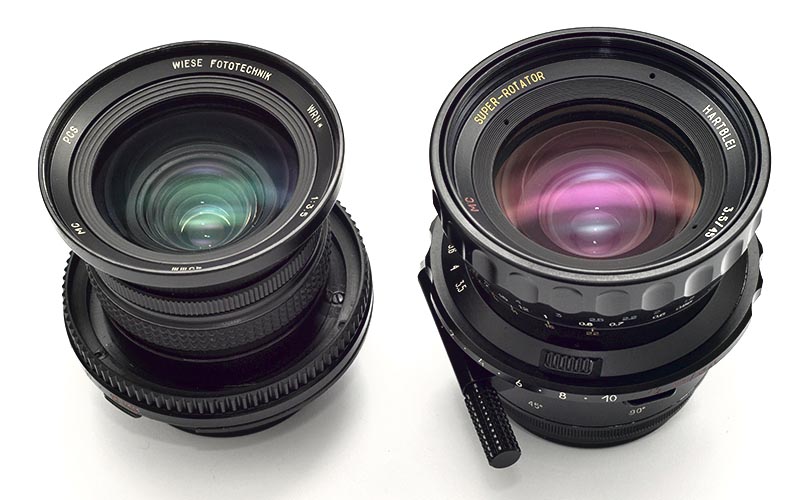 Two 45mm shift lenses: the Wiese PCS on the left and the Hartblei Super-Rotator on the right [w45pcs01.jpg] |
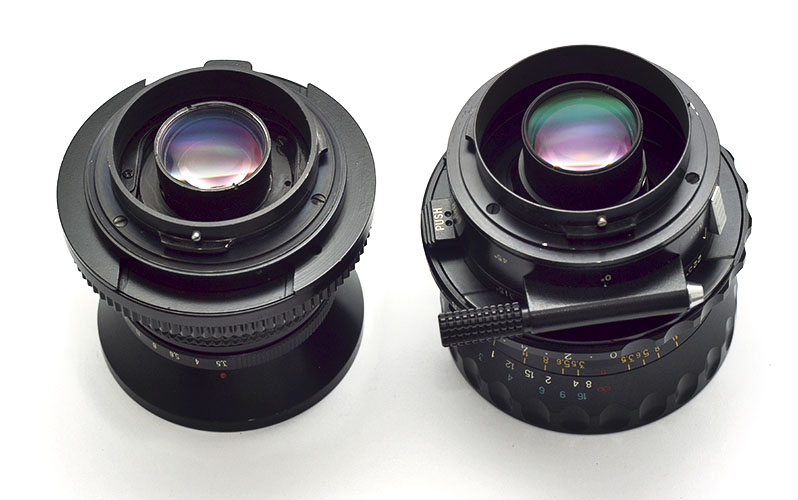 Rear view of the Wiese and the Hartblei Super-Rotator lenses, both with zero shift [w45pcs02.jpg] |
 Rear view of the same lenses at maximum shift The tabs that permit rotation of the mount are clearly visible in this image, with the one on the Hartblei lens helpfully marked “PUSH” to show the direction of movement in order to release the rotation lock. (Helpful, at least, for users who know this word in English!) [w45pcs03.jpg] |
| When we stand the Wiese
45mm PCS and the Hartblei 45mm Super-Rotator face down
(whether shifted, as here, or not), we can see that the
rearmost element projects beyond the back of the lens
mount, slightly more so, in fact, with the Wiese lens
than with the Hartblei lens that has (apparently) been
made from the same element. This is not at all surprising with such a wide-angle lens by medium format standards. However, it does mean that users should never stand either lens upright on the back of the lens without first adding a rear-lens cap, in order to protect this element from damage. |
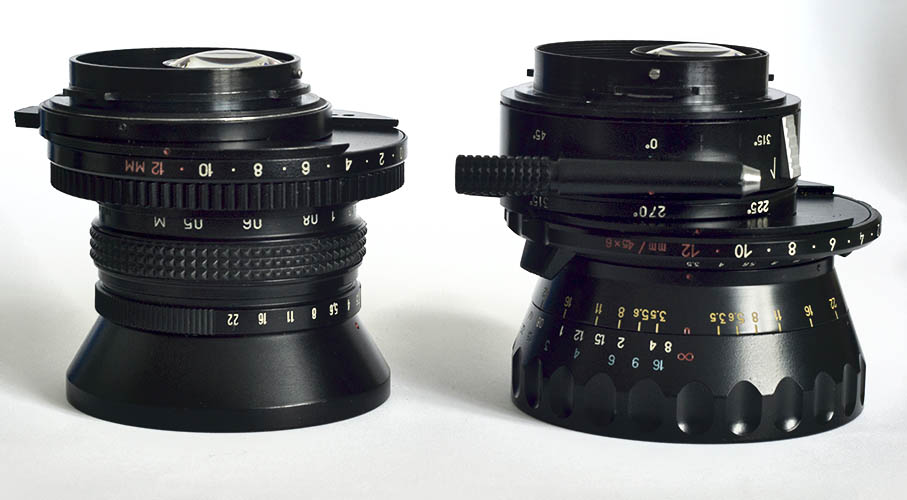 [w45pcs04.jpg] |
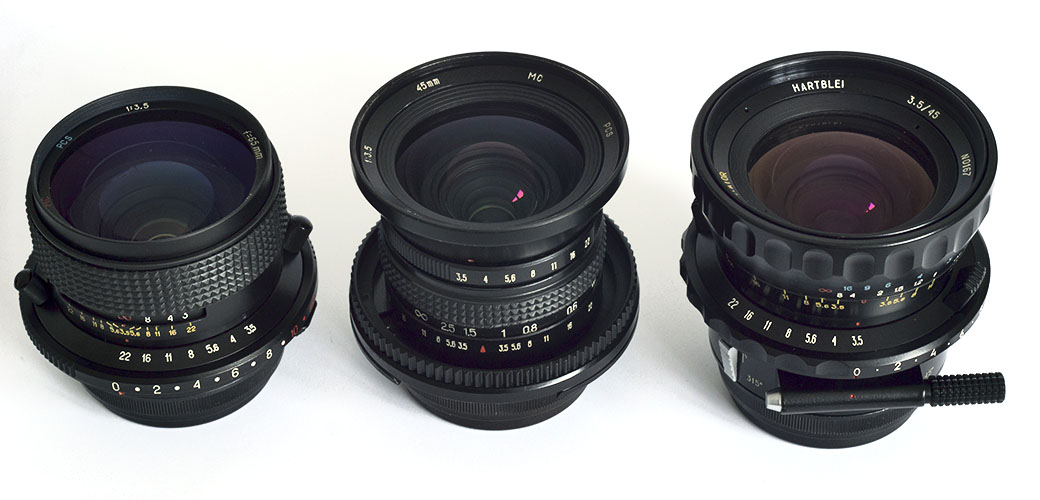 User's-eye-view of three shift lenses. From left to right: the Hartblei 65mm PCS, the Wiese 45mm PCS and the Hartblei 45mm Tilt/Shift Super-Rotator [w45pcs07.jpg]
|
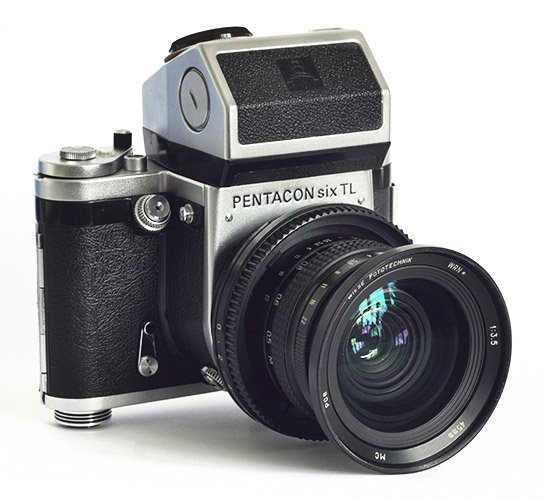 [w45pcs12.jpg]
|
The Wiese 45mm PCS shift lens
mounted on a Pentacon Six. This lens is compared with the standard Hartblei 45mm shift-only lens here. |
Different Wiese 45mm shift and
tilt lenses
A 45mm shift lens
with a very different barrel design has also been seen
with the Wiese name. Illustrated here to the
right, this, too, is a 45mm f/3.5 multi-coated lens
and it is reasonable to assume that it is derived from
the same Mir 26B elements. It bears the name
“Wiese” and “Technoplan” and I note that the name ring
also has “T3”, which has been blacked out. I
wonder if Wiese thought he was getting from his
supplier a lens that tilted as well as shifted.
Such a lens was advertised by Hartblei and most of the
barrel looks identical to this one.
|
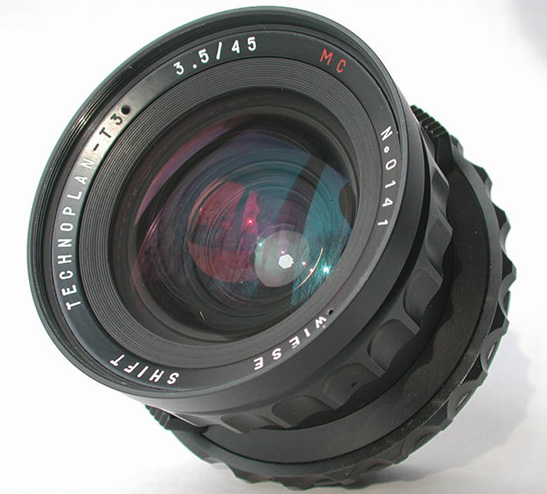 [technos01.jpg] |
| From other angles,
this Wiese Technoplan shift lens also reveals other
similarities with the above Hartblei lens. |
| The two upward-pointing tabs are
for turning the aperture ring. They are very
similar to the tabs on the 45mm Hartblei Super-Rotator
tilt-shift lens, illustrated above, and analogous to the
round tabs on the 65mm Hartblei shift lens. |
|
The rearmost “scalloped” ring sets
the amount of shift. Note that here, as on the
Super-Rotator, above, the 11mm and 12mm settings are
marked in red and followed by “/ 4.5×6” in red. |
|
This particular lens was supplied
in the type of soft bag that was commonly used from the
end of the 1990s onwards for lenses from Kiev. |
 [technos03.jpg]
|
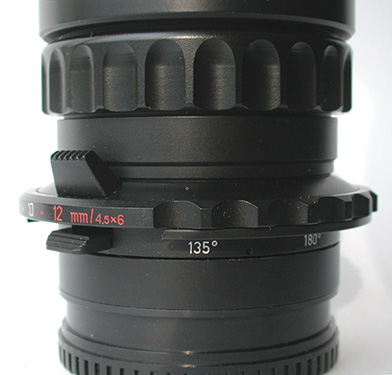 [technos04.jpg]
|
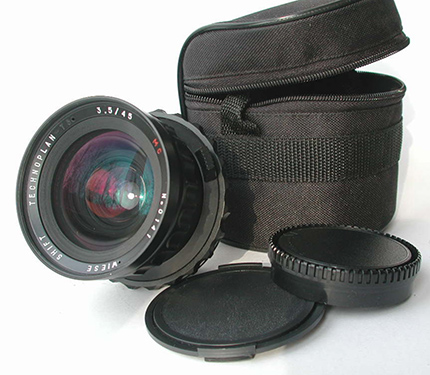 [technos05.jpg]
|
| Wiese also marketed the lens that
we know as the Hartblei 45mm Tilt-Shift Super-Rotator
lens. |
He called it the “Wiese Shift
Technoplan – T2”. This image reveals
the beauty of the multi-coating. |
|
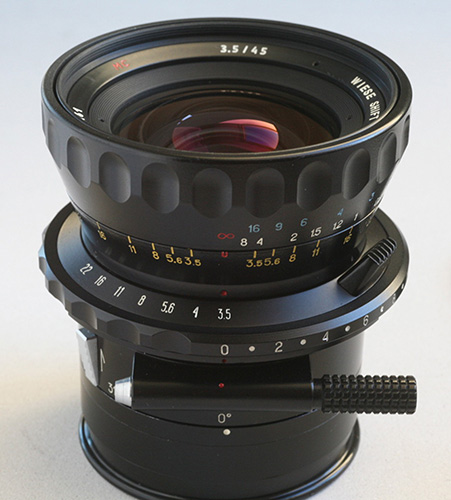 [w45mmTS01.jpg] |
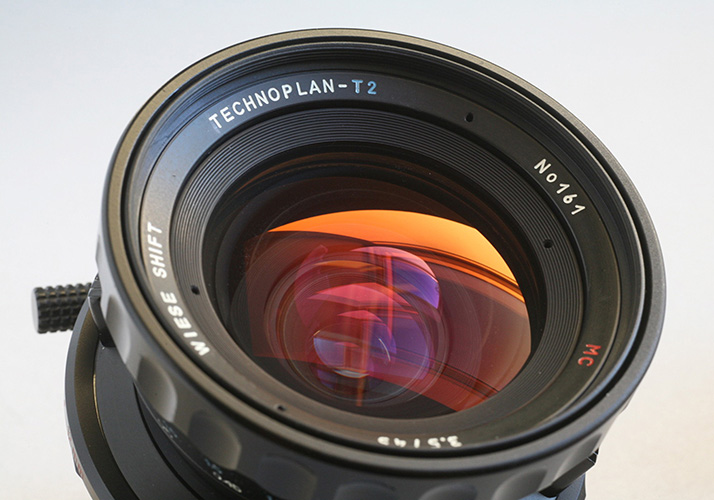 [w45TS05.jpg] |
The lens was
supplied with the special, shallow lens shade and the
usual Ukrainian soft case.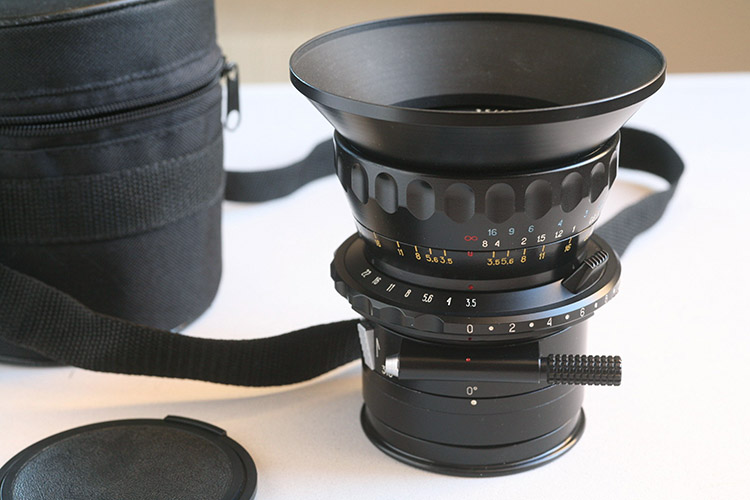 [w45mmTS10.jpg] |
See features of the Wiese 45mm shift lens, compared with
the Arsat 45mm shift lens, here.
You can see a report on an 80mm
lens from Wiese – and a camera – here.
It seems reasonable to assume that
other lenses in the Pentacon Six mount were marketed under the
Wiese name.
Where did these specialist lenses
come from? To see an attempt at discovering the
background, click here.
© TRA January 2016 Latest revision: July 2019